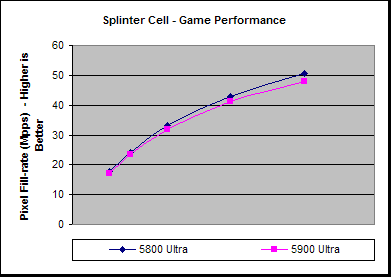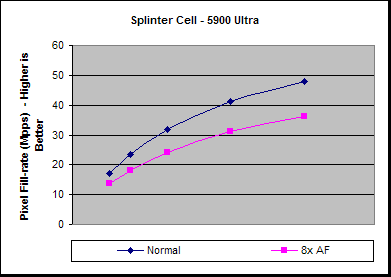Games BenchmarksSplinter CellFor the first games benchmark we'll look at the DirectX8, XBox ported title, Splinter Cell. As usual we are using Beyond3D's "The Caspian Oil Refinery" demo which makes use of a PS1.1 water surface effect. 
Interestingly, here we can see that the performance under this test in Splinter Cell actually favours the 5800 Ultra rather than the 5900 Ultra. NVIDIA state that for the 5900 Ultra the DirectX 9 shader abilities have been improved, and given the silicon demands for DX9 floating point shader units it could be reasonable to expect that this may come at the detriment of DX8 shader performance[*], however the performances here are inline with the same number of shader units running DX8 code but with the 50MHz clock speed deficit that the 5900 Ultra has. The issue we have discovered under the 44.03 drivers that afflicts the 5600, although curiously not the 5200, whereby parts of the pixel shaded water are not correctly rendered, is present on the 5800 and 5900 Ultra's as well. NVIDIA state that this will be rectified in later driver releases. * NVIDIA guards the internal shader architecture very closely, and limits the details that it give out publicly, leaving us to trying to guess what's really going on inside. NVIDIA states that for NV35 they have moved to totally floating point units in the shader pipeline, whereas NV30 featured one FP32 unit per pipe, and two FX12 integer (DX8) units per pipeline. Now, given the main issue with implementing fully floating point units previously was that of the number transistors required to do it (and hence the silicon die size costs) we can assume that removing eight FX12 units and replacing them with eight FP32 units would still require quite a transistor difference, and yet there is only a quoted addition of 5Million more transistor in NV35, which represents only a 4% difference. Given this 5 Million transistors also includes doubling the internal memory bus width from 128-bit to 256-bit it would seem unlikely from these figures that NV35 utilises a total of 12 FP32 units. For now, we are still left guessing as to its exact internal structure. 
As we have pointed out before, Splinter Cell has issues with the way Multi-Sampling FSAA (MSAA) interacts with its lighting system under current DirectX revisions and causes visual anomalies. With these drivers NVIDIA have taken the option of disabling MSAA when the application is detected in order to prevent the user being presented with these odd rendering issues. Curiously, though, where NVIDIA have disabled FSAA on all the other boards, the 5900 does render with AA enabled, though the visual issues are present, so we have not benchmarked with FSAA enabled. Enabling 8x AF here accounts for between a 20%-24% performance drop with the 5900 Ultra due to the extra number of texture samples that are required to be taken. The performance is at 30 FPS at 1024x76, but sinks a little below 20 FPS by 1600x1200. |
|
NVIDIA GeForce FX 5900 Ultra - Page 8
Published on 11th Aug 2003, written by Dave Baumann for Consumer Graphics - Last updated: 4th Jul 2007
